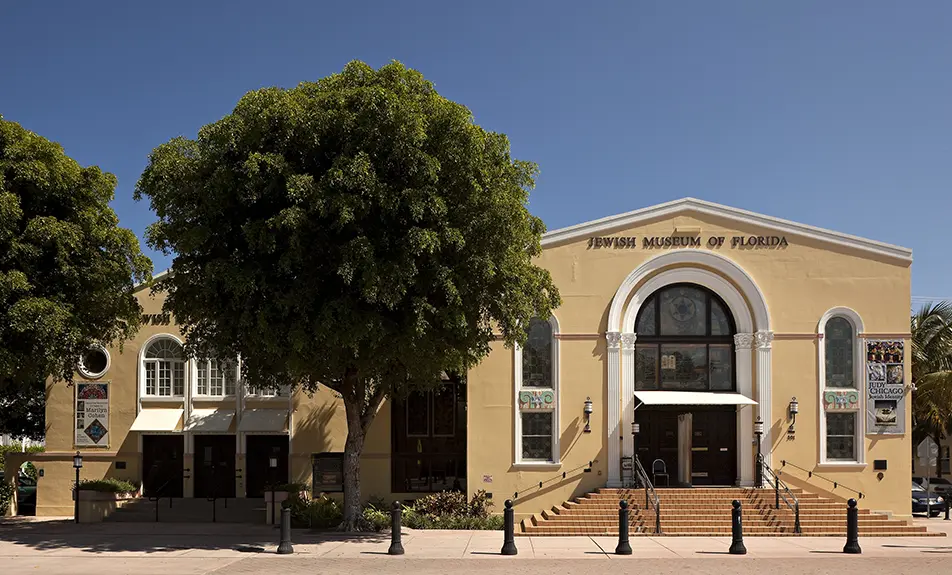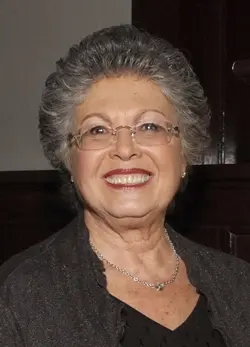The Jewish Museum of Florida is housed in two adjacent Art Deco buildings that originally served as the first synagogue and Jewish school in Miami Beach.
The Congregation Beth Jacob opened in 1929. A larger synagogue was constructed next door in 1936, and the original building served the Jewish community in other ways.
By 1995, the synagogue had moved back into the smaller building, and the Jewish Museum of Florida occupied the larger space. In 2005, the synagogue dissolved, and the museum expanded into that building.
The museum restored both Congregation Beth Jacob buildings, saving them from demolition.
Long before the Jewish Museum of Florida came into existence, founding executive director Marcia Jo Zerivitz began a quest to collect and document Jewish history throughout the state.
After moving here in 1960, Zerivitz was shocked to discover almost no documentation of Jewish history in Florida.
“I actually started a fabulous personal adventure that I think has benefited the entire state, not just the Jewish community, but the totally multi-ethnic community that we have,” says Zerivitz.
“The story that we are telling is of the immigrant experience. I think that some people tend to forget that all of us are from immigrant stock of some generation. Someone came from another place, to America, and to Florida.”
Zerivitz traveled the entire state organizing teams of volunteers in thirteen Jewish communities, including those in Pensacola, Tallahassee, Jacksonville, Orlando, Tampa, Miami, and Key West.
Since very little documentation of Jewish history existed, Zerivitz learned how to conduct interviews from renowned oral historian Samuel Proctor at the University of Florida.
For nearly a decade, Zerivitz and her teams of volunteers collected stories, photographs, and artifacts.
Professional designers were brought in to help create a touring exhibition called “Mosaic: Jewish Life in Florida.” After opening at the Historical Museum of South Florida in Miami in October, 1990, the exhibit traveled to other venues including the Flagler Museum in St. Augustine, the Museum of Florida History in Tallahassee, and the T.T. Wentworth Museum in Pensacola.
The “Mosaic” exhibition is at the heart of the Jewish Museum of Florida, but the collection continues to expand as more information and artifacts are discovered.
It is believed that Jewish people first came to Florida with the Spanish in the 1500s. Conversos were Jews who publically converted to Christianity under the threat of the Spanish Inquisition, but probably continued practicing their religion in secret. Spanish records list people with typically Jewish names among the first settlers of St. Augustine.
Historians believe that Pedro Menendez Marqués, third Spanish governor of Florida from 1577 to 1589, may have been a Converso.
Jewish people could not legally live in Florida until 1763, when the British took control of the region. That is when Alexander Solomons, Joseph de Palascios, and Samuel Israel immigrated to Pensacola, becoming the first documented Jewish people in Florida. Other families followed.
The first known Jewish child to be born in Florida was Virginia Myers, in 1822, in Pensacola.
During the Second Seminole Indian War in 1833, Fort Myers was named for quartermaster and Jewish West Point graduate Abraham Myers. The city built around that fort retains his name.
When Florida became a state in 1845, David Levy Yulee became the first Jew known to serve in the United States Senate. More than 250 mayors of Florida cities have been Jewish.
The Dzialynski family of Jacksonville is believed to be the oldest Jewish family that has continuously lived in Florida. George Dzialynski is the first Jewish boy known to be born in Florida, in 1857. The Jewish Museum of Florida proudly displays his watch.
“On the back it has a raised relief of Moses holding the Ten Commandments. It’s a beautiful artifact,” says Zerivitz. “The numerals, the hours are in Hebrew Yiddish letters. He was so proud of his Jewish heritage that he carried this watch his whole life. It also speaks loudly to the fact that Jews were here that early.”
The Jewish population of Florida exploded in the twentieth century, bringing many influential people to the state.
There are over 100,000 items in the collection at the Jewish Museum of Florida, and many stories to go with each of them.
Dr. Ben Brotemarkle is executive director of the Florida Historical Society and host of the radio program “Florida Frontiers,” broadcast locally on 90.7 WMFE Thursday evenings at 6:30 and Sunday afternoons at 4:00, and on 89.5 WFIT Sunday mornings at 7:00. The show can be heard online at myfloridahistory.org.


